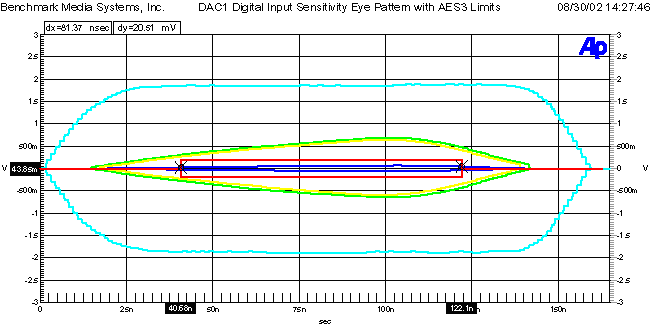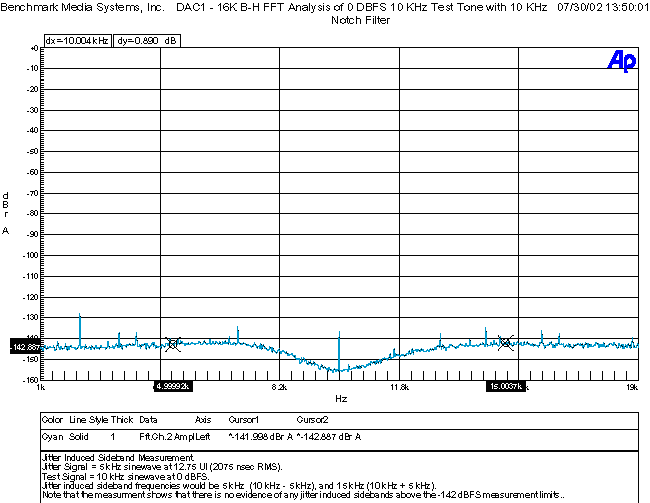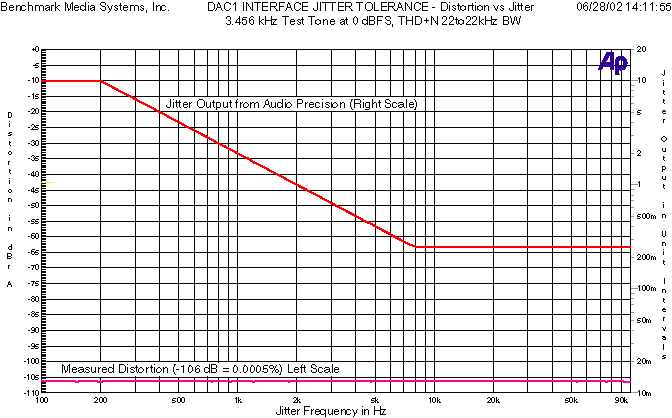John Watkinson is the author of the book, The Art of Digital Audio. In the July/August 2002 edition of Resolution, a new audio magazine from the UK, John wrote an article entitled The cable snake in a regular column feature known as “slaying dragons”.
In that article, he said “…On the other hand, if the DAC has not been properly engineered, changing the cable could affect the amount of jitter reaching the converter. Thus we finally have a practical use for exotic cables as DAC testers. If the use of an exotic cable makes a DAC sound better, then the DAC is not performing adequately and should be repaired or redesigned. If the goal is actually to achieve high quality, rather than just claim it, then this is one of the fundamental tests a designer should use.” And we would add, “Whoever heard of a DAC operating without jitter induced sidebands over 1000′ feet of garden variety data cable? Now that’s a properly engineered device!”
The following graph is a look at the Eye pattern for 1000′ of Belden MediaTwist® Cat 5e (11872A – Green) and 1000′ of General Cable Co. Cat 5e (Cat # 2133458H) – Yellow, available at Home Depot, along with the minimum signal eye pattern of the DAC1 – Blue. Also included in this graph is the normal AES/EBU four volt output level found in normal professional digital audio equipment – Cyan. The red “box” is the minimum tracking recommendation for a digital audio receiver as specified by the Audio Engineering Society. As can be seen the DAC1 easily operates with total freedom from jitter at the end of a 1000′ length of CAT5e data cable.

Cable Eye Patterns from: Normal AES (Cyan), end of 1000′ of Belden MediaTwist® (Green), 1000′ of Home Depot Cat 5e Cable (Yellow) and Minimum DAC1 Input Requirements (Blue)
The last graph shows the output of the DAC1 having been fed 12.75 unit intervals of jitter. Since jitter creates double sideband modulation products from the “carrier”, in this case a 10 kHz audio tone, and the jitter frequency is 5-kHz, jitter induced sidebands of 5 and 15-kHz should be seen if jitter makes it to the DAC decoder chip. The complete absence of these 5-kHz sidebands shows the power of UltraLock™ in providing total freedom from jitter induced audio products within the DAC1.

Total Freedom from Jitter Induced Sidebands (12.75 Unit Intervals of 5-kHz Jitter on the Audio Data)
Benchmark. That’s a loaded name for a component manufacturer. It brings to mind thoughts not only of quality build and performance but, for those philosophically inclined, also epistemological questions pertaining to the nature of high-end audio. A benchmark is a point of reference or standard by which something can be judged. Benchmark Media has chosen a bold name, one that suggests they are the standard by which listeners can judge quality music reproduction.
How do we know that a component made by a company is in fact a benchmark? How do we know it’s worthy of being the touchstone for audio reproduction? Further, how does an individual determine whether they are merely operating from their own point of reference, or from an established common point of reference? Would Benchmark’s DAC1 be a commendable component to establish a personal reference?
Every audiophile ends up selecting a personal sound preference; but there are essentially two ways to go about arriving at that preference. One may defer to authorities and mimic their expertise and recommendations. Alternatively, an individual can evaluate scads of components on their own and find their desirable sound. Even in those instances, I have not encountered any hobbyist who is completely free from the influence of others’ preferences. Often while in the search for a component they select themselves, audiophiles will scour the Earth for opinions of others.
A short while ago, Dave Magnan, the founder of Magnan Audio Cables, whose products I am currently reviewing, spoke of his and my methods of finding superior components which we have not auditioned. I cull manufacturer’s comments, professional reviews and audiophile impressions of a component while weighting each appropriately. In principle, I do not adhere strictly to one or the other reviewer’s remarks since I feel the variables inherent in reviewing are myriad, making it too difficult to isolate someone who will always hear things my way. Dave, on the other hand, focuses in on one or two reviewers who seem to have their ears tuned similarly to his own – he’s found their impressions of equipment to mirror his own. In both cases, the establishment of the reference is at least partially based in someone else’s head.
I have found that all audiophiles (this may, in fact, be universal) use someone else’s yardstick, someone else’s benchmark, in order to measure their own ability to create “good sound.” They either attend a show, read online and printed magazines, scour posts, visit a dealer, compare impressions or findings with other designers and manufacturers – somehow they connect with someone else to “compare notes.” Just as there is in reality no such thing as a “self-made” man, there is no such thing as a self-made audiophile. We all seem to pick our heroes whose sound we want to emulate in our systems.
Certainly one means of establishing a benchmark is through testing. Speaking of specifications, never have I seen such a cascade of specifications attached to a DAC as with the DAC1. I included the entire listing partially as a joke; it’s not every day that the specifications are as long as the review! However, Benchmark Media does not consider its specifications a joke – it’s evidence that they don’t fool around when it comes to assessing the performance of their designs. In answer to the epistemological question – how can we know the DAC1 is a good standard? – Benchmark is willing to trot out every iota of information to assuage the objectively minded audiophile. If you need to see numbers to convince you that a product makes good sound, Benchmark wants you to see plenty of numbers! Of course, this doesn’t necessarily mean it will sound good to your ears, but it does reinforce the belief that Benchmark is hitting the mark when they claim by way of their UltraLock technology, they have produced a DAC that is superior in eliminating jitter and revealing more detail than conventional DACs.
The DAC1 was created with three target users in mind: the professional studio, home use by audio professionals, and audiophiles. Indeed, the DAC1 has been well received by studios and has made inroads into the audiophile community. It is feature-laden and smartly laid out. Earlier versions had mounting hardware incorporated into the front plate, which weren’t the most pleasing for aesthetically picky audiophiles. The newer face plate is more comely with machined aluminum niches containing the name, three LED status display, and input selector toggle along with twin HPA2 headphone jacks. An unlit attenuator knob with a rough finish on its grip, like a weight room curling bar, completes the front. Does this suggest that professional audio engineers attempt to set levels with things like potato chip oil on their hands, hence the need for a better grip?
The back is where the real action is at, chalked full of goodies like detachable IEC, digital, optical and XLR inputs, as well as single-ended and optional calibrated or variable balanced outs. In addition to the calibrated or variable output, the analogue outputs can be muted while keeping the headphone jacks active. The rough satin black finish of the chassis, combined with the thick aluminum face plate, make the DAC1 appear business-like but not purely utilitarian. The smaller, low profile chassis meets the desires of space conscious professional users.
- (Page 1 of 1)


